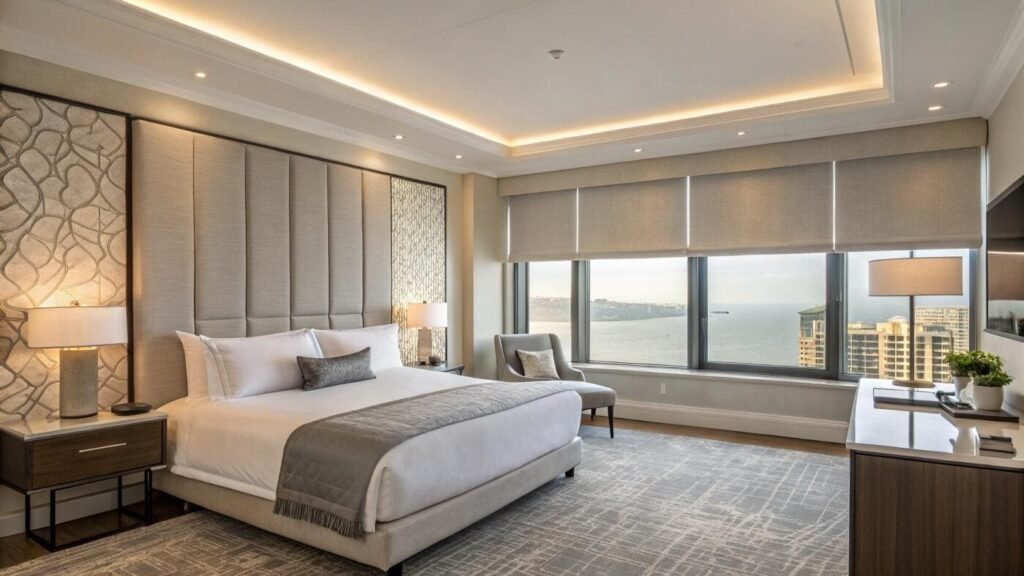Your client wants to create a healthy, allergen-free space, but you know that traditional window treatments can be magnets for dust, pollen, and dander. Now you're stuck trying to find a stylish solution.
The best blinds for allergy sufferers are roller shades[^1], aluminum blinds[^2], and PVC blinds[^3]. Their smooth, hard, non-porous surfaces[^4] don't trap dust and can be wiped clean in seconds, drastically improving indoor air quality.

I get this question all the time from designers and contractors working on health-conscious projects like clinics, modern homes, or hotels aiming for "pure wellness" rooms. The wrong choice—like a heavy fabric curtain—can become a reservoir for allergens, making a room unbearable for a sensitive person. The key is to choose materials that are easy to clean[^5] and actively resist dust buildup. Let's break down the best options so you can specify with confidence.
What blinds are the easiest to keep clean?
You've specified beautiful new blinds for a project, but now the property manager is complaining. Dust is collecting on every slat and fabric fold, and cleaning them is a time-consuming nightmare.
Roller shades, aluminum blinds, and vertical blinds are the easiest to keep clean. Their hard, smooth surfaces prevent dust from embedding itself and can be wiped down quickly with a damp cloth.

When it comes to maintenance, the surface texture is everything. This is where many projects go wrong. Textured fabrics, woven materials, and deep folds are the enemy of easy cleaning. Soft fabric Roman shades or layered curtains look cozy, but their folds are perfect traps for dust and mites. Cleaning them often requires professional dry-cleaning. In contrast, hard-surface blinds make maintenance simple and cost-effective. For a 15m² window area, a quick wipe-down of roller or PVC blinds might cost less than $30 in labor, whereas dry-cleaning curtains for the same area can cost hundreds. For any project where low maintenance is a priority, you should always choose a smooth, non-porous material.
What material is best for people with allergies?
The client is concerned about allergies, and you know the material matters more than the style. You need to choose between PVC, aluminum, and polyester to ensure the blind itself isn't part of the problem.
PVC and aluminum are the best materials for people with allergies. These hard, non-porous surfaces have a lower static charge, meaning they attract and hold less dust than any fabric, including polyester.

The science here is simple. Dust is often attracted to surfaces by static electricity. Fabrics, especially synthetics like polyester, can build up a static charge that acts like a magnet for dust particles. Hard materials do not.
| Material | Surface Type | Dust Adhesion | Best For Allergies? |
|---|---|---|---|
| Aluminum | Hard, Non-Porous | Very Low | Excellent |
| PVC | Hard, Non-Porous | Very Low | Excellent |
| Polyester | Woven Fabric | Moderate | Good (if smooth weave) |
| Natural Fabric | Textured, Porous | High | Poor |
For projects in humid areas where relative humidity is over 70%, dust mites[^6] become a major concern. Mites thrive in porous, moisture-retaining fabrics. In these cases, I always recommend PVC or aluminum. They offer zero habitat for mites. When I'm preparing a specification sheet for a project in a humid climate, I explicitly state "non-porous, easy-wipe material required" to ensure the right product is used.
Can cordless or motorized blinds reduce dust?
You’ve chosen the perfect dust-resistant material for the blinds. But what about the messy cords, chains, and wands? They are just more surfaces for dust to collect on.
Yes, absolutely. Upgrading to a cordless or motorized system[^7] can reduce the number of dust-collecting parts on a blind by up to 40%. It creates a cleaner, more minimalist look and simplifies maintenance.

This is a detail that often gets overlooked. The control mechanism itself can be a major dust trap. Dangling bead chains, thick cords, and tilting wands are all awkward to clean and add visual clutter. When you switch to a motorized system, you eliminate all of that. All you have left is the clean, simple shade itself. This has two major benefits for your projects. First, it directly addresses the allergy concern by removing surfaces where dust can accumulate. Second, it solves the child safety issue by removing hazardous looped cords—a huge value-add for residential projects. For me, motorization is a clear win-win, offering a healthier, safer, and more user-friendly solution.
Do anti-static coatings[^8] on blinds really work?
You've seen some suppliers advertising an "anti-static coating" as the ultimate solution for dust. You're skeptical if this is a real feature or just a marketing gimmick to charge more.
Anti-static coatings do work, but they are not a permanent solution. A good quality coating will effectively repel dust for about 2-3 years before its performance starts to decline.

These coatings are a real technology. They apply a microscopic chemical layer to the blind's surface that dissipates static charge, making it much harder for dust to stick. For the first couple of years, you'll notice a significant reduction in dust buildup. However, cleaning and general exposure to the air will wear down this coating over time. As a supplier, this is something I am very transparent about with my project partners. For high-end commercial projects, like premium hotels or corporate offices, we can even write a "secondary spray" service into the contract. This allows the maintenance team to reapply the coating after 2 or 3 years, extending the life and performance of the blinds and ensuring they continue to meet a high standard of cleanliness.
Are there hypoallergenic curtains?
Your client loves the soft, traditional look of curtains but is deeply concerned about allergies. You're trying to find a "hypoallergenic" fabric that won't become a haven for dust and mites.
While some synthetic curtains are called "hypoallergenic," no curtain is truly dust-proof. All fabrics trap more allergens than hard blinds and require frequent, labor-intensive cleaning to keep them healthy.

"Hypoallergenic" in the context of curtains is mostly a marketing term. It usually just means the fabric itself (like polyester) is less likely to cause an allergic reaction than a natural fiber like wool. It does not mean the curtain won't trap dust, pollen, pet dander, and dust mites. In fact, their large, textured surface and folds are the perfect environment for these allergens. To keep curtains clean, they must be taken down, washed or dry-cleaned, and re-hung—a massive chore. If a client insists on the softness of fabric, I recommend a layered approach: use a functional, easy-to-clean roller shade as the primary window covering for dust and light control, and then add stationary, lightweight decorative curtain panels on the sides that can be easily removed and laundered. This provides the best of both worlds.
Conclusion
For allergy sufferers, always choose hard-surface blinds like rollers, aluminum, or PVC. They resist dust, are incredibly easy to clean, and provide a healthier, more modern solution than any fabric-based window treatment.
---
[^1]: Explore how roller shades can enhance indoor air quality and reduce allergens effectively.
[^2]: Learn why aluminum blinds are a top choice for maintaining a dust-free environment.
[^3]: Discover the advantages of PVC blinds in reducing allergens and improving air quality.
[^4]: Understand how non-porous surfaces help in minimizing dust and allergens.
[^5]: Find out which window treatments require minimal maintenance and are allergy-friendly.
[^6]: Learn about the impact of dust mites on health and how to reduce their presence.
[^7]: Discover the advantages of motorized systems in minimizing dust-collecting surfaces.
[^8]: Find out how effective anti-static coatings are in repelling dust and allergens.Partner with VelaBlinds for Your Next Project
Smart window treatments shouldn't be complicated. After working with 500+ distributors and contractors worldwide, I've streamlined the process to get you quality products, competitive pricing, and reliable support - every time.
Why project professionals choose VelaBlinds:
- ✅ Fast, Accurate Quotes - Detailed specs and pricing within 24 hours
- ✅ Transparent Pricing - No hidden fees, volume discounts clearly outlined
- ✅ Quality Assurance - Direct partnerships with certified OEM manufacturers
- ✅ Project Support - Dedicated account manager from quote to delivery
Start your next project:
📧 Quick Quote: Send your requirements to info@velablinds.com
📱 Direct Contact: WhatsApp +86 137 2012 8317
🌐 Browse Solutions: https://velablinds.com/
📁 Product Resources: Access spec sheets, catalogs & project files
Paul Chen, Founder
"I built VelaBlinds to solve the real challenges I faced as a project buyer - long lead times, unclear specs, and unreliable suppliers. Let's discuss how we can power your projects with smarter blinds."
Serving distributors and contractors across North America, Europe, and Australia since 2018.




